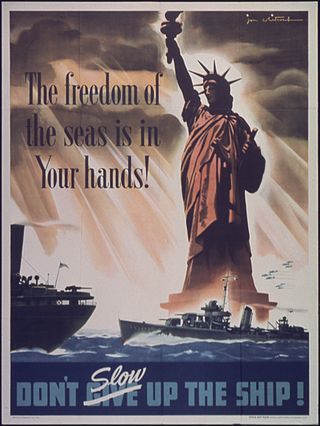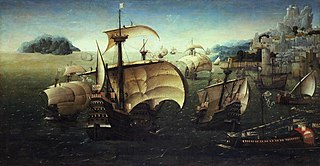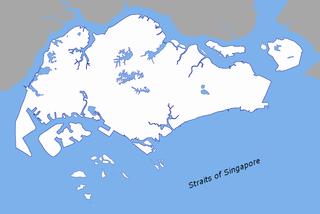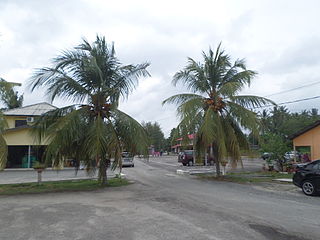
A letter of marque and reprisal was a government license in the Age of Sail that authorized a private person, known as a privateer or corsair, to attack and capture vessels of a nation at war with the issuer. After capturing, the privateers could bring the case of that prize before their own admiralty court for condemnation and transfer of ownership to the privateer. A letter of marque and reprisal would include permission to cross an international border to conduct a reprisal and was authorized by an issuing jurisdiction to conduct reprisal operations outside its borders.

Hugo Grotius, also known as Hugo de Groot or Huig de Groot, was a Dutch humanist, diplomat, lawyer, theologian, jurist, statesman, poet and playwright. A teenage prodigy, he was born in Delft and studied at Leiden University. He was imprisoned in Loevestein Castle for his involvement in the controversies over religious policy of the Dutch Republic, but escaped hidden in a chest of books that was transported to Gorinchem. Grotius wrote most of his major works in exile in France.

Freedom of the seas is a principle in the law of the sea. It stresses freedom to navigate the oceans. It also disapproves of war fought in water. The freedom is to be breached only in a necessary international agreement.

Law of the sea is a body of international law governing the rights and duties of states in maritime environments. It concerns matters such as navigational rights, sea mineral claims, and coastal waters jurisdiction.

A carrack is a three- or four-masted ocean-going sailing ship that was developed in the 14th to 15th centuries in Europe, most notably in Portugal and Spain. Evolved from the single-masted cog, the carrack was first used for European trade from the Mediterranean to the Baltic and quickly found use with the newly found wealth of the trade between Europe and Africa and then the trans-Atlantic trade with the Americas. In their most advanced forms, they were used by the Portuguese for trade between Europe and Asia starting in the late 15th century, before eventually being superseded in the 17th century by the galleon, introduced in the 16th century.

The Singapore Strait is a 113 km-long (70 mi), 19 km-wide (12 mi) strait between the Strait of Malacca in the west and the South China Sea in the east. Singapore is on the north of the channel, and the Indonesian Riau Islands are on the south. The two countries share a maritime border along the strait.

The Johor Sultanate was founded by Malaccan Sultan Mahmud Shah's son, Sultan Alauddin Riayat Shah II in 1528. Prior to being a sultanate of its own right, Johor had been part of the Malaccan Sultanate before the Portuguese conquered its capital in 1511. At its height, the sultanate controlled areas in what is now modern-day Johor, Pahang, Terengganu, territories stretching from the rivers of Klang to the Linggi and Tanjung Tuan, respectively situated in the states of Selangor, Negeri Sembilan and Malacca, Singapore, Pulau Tinggi and other islands off the east coast of the Malay peninsula, the Karimun islands, the islands of Bintan, Bulang, Lingga and Bunguran, and Bengkalis, Kampar and Siak in Sumatra. During the colonial era, the mainland part was administered by the British, and the insular part by the Dutch, thus breaking up the sultanate into Johor and Riau. In 1946, the British section became part of the Malayan Union. Two years later, it joined the Federation of Malaya and subsequently, the Federation of Malaysia in 1963. In 1949, the Dutch section became part of Indonesia.
Freedom of navigation (FON) is a principle of law of the sea that ships flying the flag of any sovereign state shall not suffer interference from other states, apart from the exceptions provided for in international law. In the realm of international law, it has been defined as “freedom of movement for vessels, freedom to enter ports and to make use of plant and docks, to load and unload goods and to transport goods and passengers". This right is now also codified as Article 87(1)a of the 1982 United Nations Convention on the Law of the Sea.

The Dutch–Portuguese War was a global armed conflict involving Dutch forces, in the form of the Dutch East India Company, the Dutch West India Company, and their allies, against the Iberian Union, and after 1640, the Portuguese Empire. Beginning in 1598, the conflict primarily involved the Dutch companies and fleet invading Portuguese colonies in the Americas, Africa, and the East Indies. The war can be thought of as an extension of the Eighty Years' War being fought in Europe at the time between Spain and the Netherlands, as Portugal was in a dynastic union with Spain after the War of the Portuguese Succession, for most of the conflict.

In admiralty law prizes are equipment, vehicles, vessels, and cargo captured during armed conflict. The most common use of prize in this sense is the capture of an enemy ship and her cargo as a prize of war. In the past, the capturing force would commonly be allotted a share of the worth of the captured prize. Nations often granted letters of marque that would entitle private parties to capture enemy property, usually ships. Once the ship was secured on friendly territory, she would be made the subject of a prize case: an in rem proceeding in which the court determined the status of the condemned property and the manner in which the property was to be disposed of.

Johor Lama is a mukim in Kota Tinggi District, Johor, Malaysia. It is situated on the banks of Johor River. It was once a thriving port and the old capital of the Johor Sultanate.

The early history of Singapore refers to its pre-colonial era before 1819, when the British East India Company led by Stamford Raffles established a trading settlement on the island and set in motion the history of modern Singapore.
Mare clausum is a term used in international law to mention a sea, ocean or other navigable body of water under the jurisdiction of a state that is closed or not accessible to other states. Mare clausum is an exception to mare liberum, meaning a sea that is open to navigation to ships of all nations. In the generally accepted principle of international waters, oceans, seas, and waters outside national jurisdiction are open to navigation by all and referred to as "high seas" or mare liberum. Portugal and Spain defended a Mare clausum policy during the Age of Discovery. This was soon challenged by other European nations.
The Treaty of Antwerp, which initiated the Twelve Years' Truce, was an armistice signed in Antwerp on 9 April 1609 between Spain and the Netherlands, creating the major break in hostilities during the Eighty Years' War for independence conducted by the Seventeen Provinces in the Low Countries.
The three-mile limit refers to a traditional and now largely obsolete conception of the international law of the seas which defined a country's territorial waters, for the purposes of trade regulation and exclusivity, as extending as far as the reach of cannons fired from land.
William Welwod (1578–1622) was a Scottish jurist who was the first to formulate the laws of the sea in an insular Germanic language.

Mare Liberum is a book in Latin on international law written by the Dutch jurist and philosopher Hugo Grotius, first published in 1609. In The Free Sea, Grotius formulated the new principle that the sea was international territory and all nations were free to use it for seafaring trade. The disputation was directed towards the Portuguese Mare clausum policy and their claim of monopoly on the East Indian Trade. Grotius wrote the treatise while being a counsel to the Dutch East India Company over the seizing of the Santa Catarina Portuguese carrack issue. The work was assigned to Grotius by the Zeeland Chamber of the Dutch East India Company in 1608.
Sultan Alauddin Riayat Shah III was the Sultan of Johor who reigned from 1597 to 1615. He resided at the new capital of Johor at Batu Sawar, but later moved his administration to Pasir Raja around 1609. In 1612, at the instigation of his co-ruler and half-brother Abdullah, and Bendahara Tun Sri Lanang oversaw the editorial and compilation process of the Sejarah Melayu, the most important Malay literary work of all time.
Sultan Abdullah Ma'ayat Shah was Sultan of Johor from 1615 to 1623. Before he became sultan of Johor, Abdullah Ma'ayat Shah was also known as Raja Bongsu, Raja Seberang or Raja di Hilir.
Franciscus Serafim de Freitas was a Portuguese jurist and canon lawyer.











